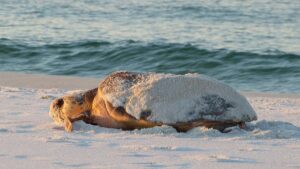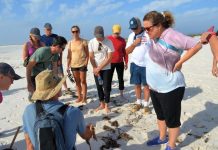Las tortugas marinas regresan a la playa de Pensacola
PENSACOLA BEACH, Fla. – Con la reciente reapertura de Pensacola Beach, el SRIA también da la bienvenida a las tortugas marinas amenazadas y en peligro de extinción, que deberían comenzar a llegar a nuestras costas muy pronto para comenzar a anidar.
“El 1 de mayo marca el comienzo de la temporada de anidación de tortugas marinas en la isla de Santa Rosa,” dijo Paolo Ghio, director ejecutivo de la SRIA. “Por lo tanto, es vital que todos los bañistas aumenten su conocimiento de la ordenanza “Leave No Trace Behind” (“No dejar rastro atrás”) y dejen solo sus huellas. Esto se aplica durante todo el año, pero es especialmente importante durante la temporada de anidación de tortugas marinas.”
A principios de mayo, las tortugas Loggerhead, Green y, en raras ocasiones, las tortugas Leatherback y Kemp’s Ridley eligen la playa de Pensacola para anidar. Las madres tortugas marinas regresan a la playa de Pensacola, la misma playa en la que nacieron, para desovar, generalmente de noche.
Aproximadamente 50 a 60 días después de que una tortuga marina madre arrastra su pesado cuerpo hacia nuestras costas, cava un hoyo en la arena con sus aletas y pone sus huevos, sus huevos están listos para salir del cascarón. La temporada de eclosión en la playa de Pensacola se extiende hasta finales de octubre, y la época de eclosión suele ser en agosto y septiembre.
Casi todas las especies de tortugas marinas se clasifican como amenazadas o en peligro de extinción. Las crías de tortugas marinas enfrentan muchos obstáculos cuando salen de sus nidos, como mapaches, cangrejos, pájaros y peces. Las crías de tortugas marinas también usan la luz de la luna para guiarse al agua, pero pueden distraerse con las luces brillantes de las áreas desarrolladas.
Solo 1 de cada 1,000 crías sobrevivirá hasta la edad adulta. Por eso es tan importante ser siempre respetuoso y considerado de la anidación de las tortugas marinas y las crías para garantizar que las generaciones futuras también las disfruten.
Aquí hay algunos consejos útiles:
- Al caminar por la playa por la noche durante la temporada de tortugas, recuerde usar una linterna roja o ninguna. La luz de la luna puede ser todo lo que necesitas. Por favor mantenga su propiedad oscura también. Las tortugas marinas y las crías tienen menos probabilidades de ser atraídas y desorientadas por la luz roja.
- Nunca toque o acose a una tortuga marina que anida o a sus crías cuando salen de su nido. Mire en silencio desde la distancia y nunca encienda luces ni use fotografías con flash, lo que podría desorientarlas.
- Rellene agujeros grandes, derribe castillos de arena y otros obstáculos para dejar la playa plana para anidar las tortugas marinas y sus crías.
- Retire todas las carpas, toldos, muebles, juguetes y otros obstáculos de la playa todas las noches.
Si ve una tortuga marina o cría enferma, herida, angustiada o fallecida, llame a la línea directa de Florida Fish and Wildlife Conservation Commission (La Comisión de Conservación de Pesca y Vida Silvestre de Florida) las 24 horas al 888-404-3922.
Sea turtles return to Pensacola Beach
 PENSACOLA BEACH, Fla. — With the recent reopening of Pensacola Beach, the SRIA also welcomes back threatened and endangered sea turtles, which should begin arriving on our shores very soon to begin nesting.
PENSACOLA BEACH, Fla. — With the recent reopening of Pensacola Beach, the SRIA also welcomes back threatened and endangered sea turtles, which should begin arriving on our shores very soon to begin nesting.
“May 1 marks the start of sea turtle nesting season on Santa Rosa Island,” said Paolo Ghio, executive director of the SRIA. “So it’s vital that all beachgoers increase their awareness of the “Leave No Trace Behind” ordinance and leave only their footprints behind. This applies year-round, but is especially important during sea turtle nesting season.”
Beginning in early May, Loggerhead, Green, and on rare occasions, Leatherback and Kemp’s Ridley sea turtles choose Pensacola Beach for nesting. Mother sea turtles return to Pensacola Beach, the same beach on which they were born, to lay their eggs — usually at night.
About 50 to 60 days after a mother sea turtle hauls her heavy body onto our shores, digs a hole in the sand with her flippers, and lays her eggs – her eggs are ready to hatch. Hatchling season on Pensacola Beach runs through the end of October, with the height of hatching usually in August and September.
Nearly all species of sea turtle are classified as threatened or endangered. Baby sea turtles face many obstacles when first leaving their nests — such as raccoons, crabs, birds and fish. Sea turtle hatchlings also use the light of the moon to guide themselves to the water, but can get distracted by bright lights from the developed areas.
Only 1 in 1,000 hatchlings will survive to adulthood. That’s why it’s so important to always be respectful and considerate of nesting sea turtles and hatchlings to ensure that future generations get to enjoy them too.
Here are some helpful tips:
- When walking the beach at night during turtle season, remember to use a red flashlight or none at all. Moonlight may be all you need. Please keep your property dark too. Sea turtles and hatchlings are less likely to be attracted and disoriented by red lighting.
- Never touch or harass a nesting sea turtle or baby hatchlings as they leave their nest. Watch quietly from a distance and never shine lights or use flash photography, which could disorient them.
- Fill in large holes, knock down sandcastles and other obstacles to leave the beach flat for nesting sea turtles and their hatchlings.
- Remove all tents, canopies, furniture, toys and other obstacles from the beach every night.
If you see a sea turtle or hatchling that is sick, injured, in distress or deceased, call the Florida Fish and Wildlife Conservation Commission 24-hour hotline at 888-404-3922.

















